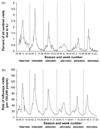Age-related trends in the timeliness and prediction of medical visits, hospitalizations and deaths due to pneumonia and influenza, British Columbia, Canada, 1998-2004
- PMID: 18280620
- PMCID: PMC2376828
- DOI: 10.1016/j.vaccine.2007.11.090
Age-related trends in the timeliness and prediction of medical visits, hospitalizations and deaths due to pneumonia and influenza, British Columbia, Canada, 1998-2004
Abstract
The influenza immunization program in North America has been primarily designed to provide direct benefit to vaccinated individuals at highest risk of serious influenza outcomes. Some evidence suggests that immunization of certain age groups may also extend indirect protective benefit to vulnerable populations. Our goal was to identify age groups associated earliest with seasonal influenza activity and who may have the greatest indirect impact at the population level. We examined age-based associations between influenza medical visits and population-wide hospitalization/mortality due to pneumonia & influenza (P&I) using administrative datasets in British Columbia, Canada. A peak week was identified for each age group based on the highest rates observed in a given week for that study year. Mean rates at the peak week were averaged over the study years per age group. Timeliness (T) was defined as the mean difference in days between the first peak in influenza medical visits and population-wide P&I hospitalizations/deaths. Poisson regression was applied to calculate prediction (Pr) as the average proportion of deviance in P&I explained by influenza medical visits. T and Pr were derived by age group, and the product (T x Pr) was used as a summary measure to rank potential indirect effects of influenza by age group. Young children (0-23 months) and the elderly (> or = 65 years) had the highest peak rates of P&I hospitalization. Children < 6m and the elderly had the highest peak rates of P&I mortality. We found no significant differences by age for influenza medical visits in predicting population-wide P&I hospitalizations or deaths. School-aged children (5-19 years) showed the best relative combination of T x Pr, followed by preschool-aged children (2-4 years). We conclude that the very young and old suffer the greatest morbidity due to P&I, and an indirect role for school-aged children in anticipating the risk to others warrants further evaluation.
Figures


Similar articles
-
Incidence of outpatient visits and hospitalizations related to influenza in infants and young children.Pediatrics. 2004 Mar;113(3 Pt 1):585-93. doi: 10.1542/peds.113.3.585. Pediatrics. 2004. PMID: 14993554
-
The impact of influenza-associated respiratory illnesses on hospitalizations, physician visits, emergency room visits, and mortality.Can J Public Health. 2003 Jan-Feb;94(1):59-63. doi: 10.1007/BF03405054. Can J Public Health. 2003. PMID: 12583681 Free PMC article.
-
Model estimates of the burden of outpatient visits attributable to influenza in the United States.BMC Infect Dis. 2016 Nov 7;16(1):641. doi: 10.1186/s12879-016-1939-7. BMC Infect Dis. 2016. PMID: 27821091 Free PMC article.
-
Laboratory-Confirmed Influenza-Associated Hospitalizations Among Children and Adults - Influenza Hospitalization Surveillance Network, United States, 2010-2023.MMWR Surveill Summ. 2024 Oct 31;73(6):1-18. doi: 10.15585/mmwr.ss7706a1. MMWR Surveill Summ. 2024. PMID: 39471107 Free PMC article.
-
Uncovering the burden of Influenza in children in Portugal, 2008-2018.BMC Infect Dis. 2024 Jan 18;24(1):100. doi: 10.1186/s12879-023-08685-z. BMC Infect Dis. 2024. PMID: 38238649 Free PMC article. Review.
Cited by
-
Physician surveillance of influenza: collaboration between primary care and public health.Can Fam Physician. 2014 Jan;60(1):e7-15. Can Fam Physician. 2014. PMID: 24452584 Free PMC article.
-
The management of community-acquired pneumonia in infants and children older than 3 months of age: clinical practice guidelines by the Pediatric Infectious Diseases Society and the Infectious Diseases Society of America.Clin Infect Dis. 2011 Oct;53(7):e25-76. doi: 10.1093/cid/cir531. Epub 2011 Aug 31. Clin Infect Dis. 2011. PMID: 21880587 Free PMC article.
-
Contact, Travel, and Transmission: The Impact of Winter Holidays on Influenza Dynamics in the United States.J Infect Dis. 2017 Mar 1;215(5):732-739. doi: 10.1093/infdis/jiw642. J Infect Dis. 2017. PMID: 28031259 Free PMC article.
-
Determining the dynamics of influenza transmission by age.Emerg Themes Epidemiol. 2014 Mar 21;11(1):4. doi: 10.1186/1742-7622-11-4. Emerg Themes Epidemiol. 2014. PMID: 24656239 Free PMC article.
-
Using age, triage score, and disposition data from emergency department electronic records to improve Influenza-like illness surveillance.J Am Med Inform Assoc. 2015 May;22(3):688-96. doi: 10.1093/jamia/ocu002. Epub 2015 Feb 26. J Am Med Inform Assoc. 2015. PMID: 25725005 Free PMC article.
References
-
- Simonsen L, Fukuda K, Schonberger LB, Cox NJ. The impact of influenza epidemics on hospitalizations. J Infect Dis. 2000 March;181(3):831–837. - PubMed
-
- Thompson WW, Shay DK, Weintraub E, Brammer L, Cox N, Anderson LJ, et al. Mortality associated with influenza and respiratory syncytial virus in the United States. JAMA. 2003 January 8;289(2):179–186. - PubMed
-
- Glezen WP, Couch RB. Estimating deaths due to influenza and respiratory syncytial virus. JAMA. 2003 May 21;289(19):2500–2502. - PubMed
-
- Thompson WW, Shay DK, Weintraub E, Brammer L, Bridges CB, Cox NJ, et al. Influenza-associated hospitalizations in the United States. JAMA. 2004 September 15;292(11):1333–1340. - PubMed
Publication types
MeSH terms
Grants and funding
LinkOut - more resources
Full Text Sources
Medical
Research Materials

